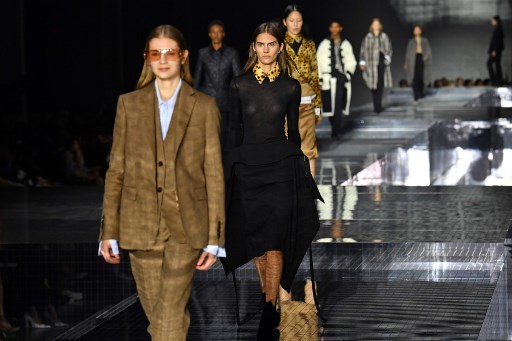British style, sustainable collections and Chinese participation on the slide: here are the takeaways from London Fashion Week, which ended on Tuesday:
– Shadow of coronavirus –
The involvement of Chinese retailers and media was sharply down at LFW due to travel restrictions imposed because of the COVID-19 virus outbreak. It was a heavy blow for the industry as China is the world’s biggest consumer of luxury fashion goods. The epidemic has had a significant negative impact on demand, Burberry warned on February 7.
The brand was temporarily forced to close 24 of its 64 stores in China, while the rest operated on reduced hours.The British Fashion Council deep-cleaned the main London venue, with disinfectant on hand.

However, only a few catwalk models wore facemasks — matching their outfits, of course.
– Upbeat stylists –
If COVID-19 fears and the winter blues are getting you down, then the colourful collections of Serbia’s Roksanda or Britain’s Molly Goddard could bring a dose of cheer.
Among Roksanda’s more striking creations was a voluminous evening dress in neon orange silk, with a purple train.
Goddard’s emblematic tulle dresses lend a child-like and joyous look.
Textures and volumes are the new chic, said JW Anderson.
For his new collection, Anderson said he wanted something “kind of optimistic”.
Anderson, who lived in Northern Ireland during his youth, he was inspired by Guinness stout for the colours and designs of some of his dresses.
“There was something nice in the typography of Guinness — there was gold, there was black, a little touch of silver and a burgundy colour,” he said.
And if you fancy being the queen of the night, Halpern’s tight-fitting jumpsuit in multicoloured sequins could be just the ticket, or perhaps a crystal-studded costume with matching hood by Richard Quinn.
With these sparkling creations, Quinn was reflecting London’s Pearly Kings and Queens, working-class icons who decorated their outfits with hundreds of mother-of-pearl buttons.
– Exploration of British style –
At a moment of introspection for Britain after it left the European Union, designers turned to typically British materials such as Harris tweed from Vivienne Westwood, with classic beige and violet lines.
Margaret Howell, who is celebrating her brand’s 50th anniversary, stuck with a British look with a short trench coat worn with bare legs, pleated skirts, and ties casually tied around blouses, in a schoolgirl chic style.
In Scottish tartan, the Shrimps models look ready for a weekend at Balmoral, Queen Elizabeth II’s Scottish country retreat.
For Burberry, creative director Riccardo Tisci continues to revisit the trench coat that made the brand famous, rejuvenating it and making it sexier.
For his fourth season, he notably created trench coat-puffer jacket hybrids and daringly mixed different grid prints.
– Environmental awareness –
Designers can no longer ignore the industry’s environmental impact — something campaigners Extinction Rebellion tried to remind them of on Saturday.
Through the use of renewable materials and “upcycling” — reusing used clothing materials — innovative stylists were featured in an exhibition on “positive fashion”.
The big brands are also evolving. Burberry announced that its fashion show was certified neutral in terms of carbon emissions, while Tommy Hilfiger claims his spring 2020 collection is the most environmentally-friendly ever produced.
As a reflection of this changing industry, Ireland’s Richard Malone, one of the most advanced young designers in terms of sustainable development, received the international Woolmark prize on Monday.
Meanwhile the first Karl Lagerfeld prize for innovation went to Emily Adams Bode of the United States, an “upcycling” star.
Photos courtesy Agence France-Presse